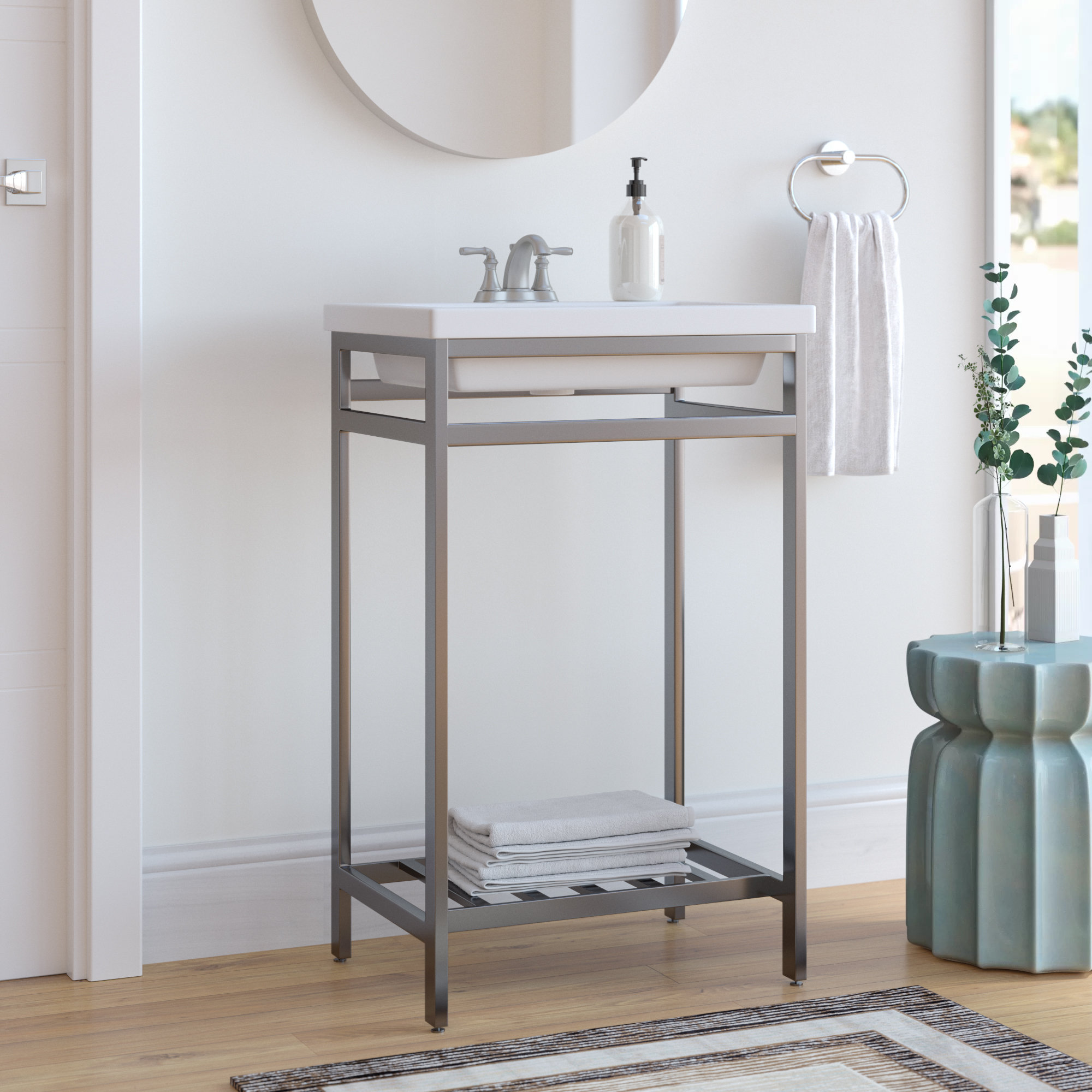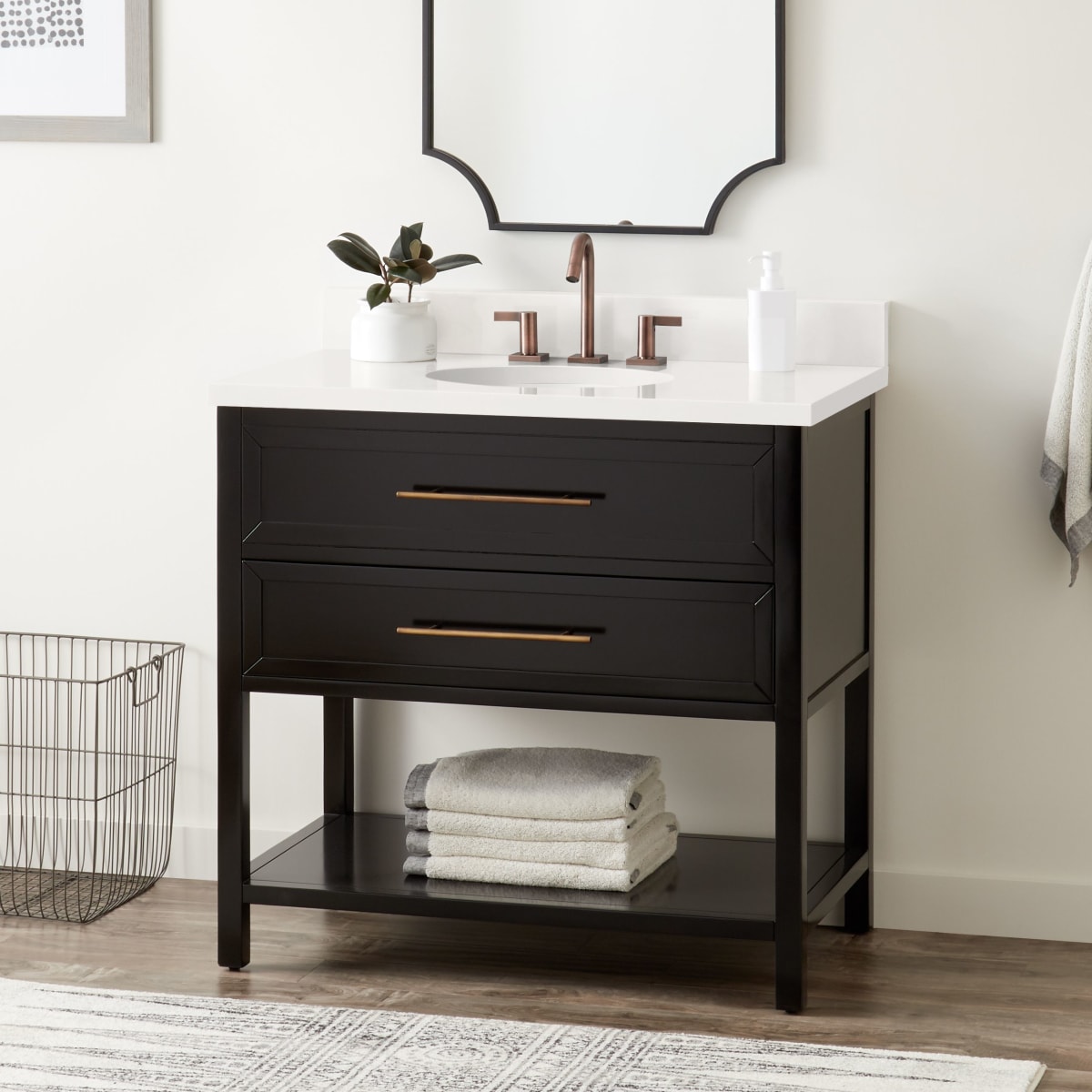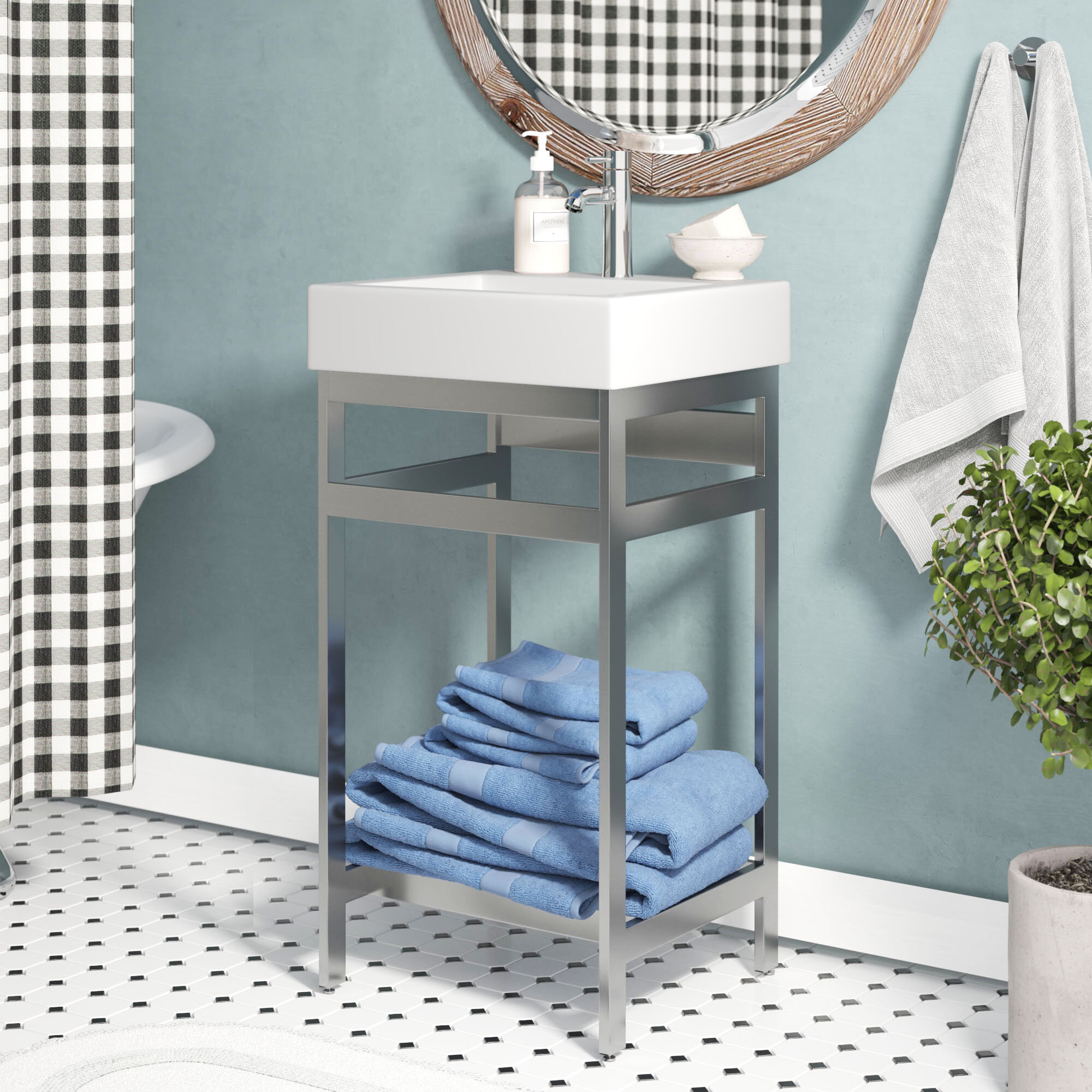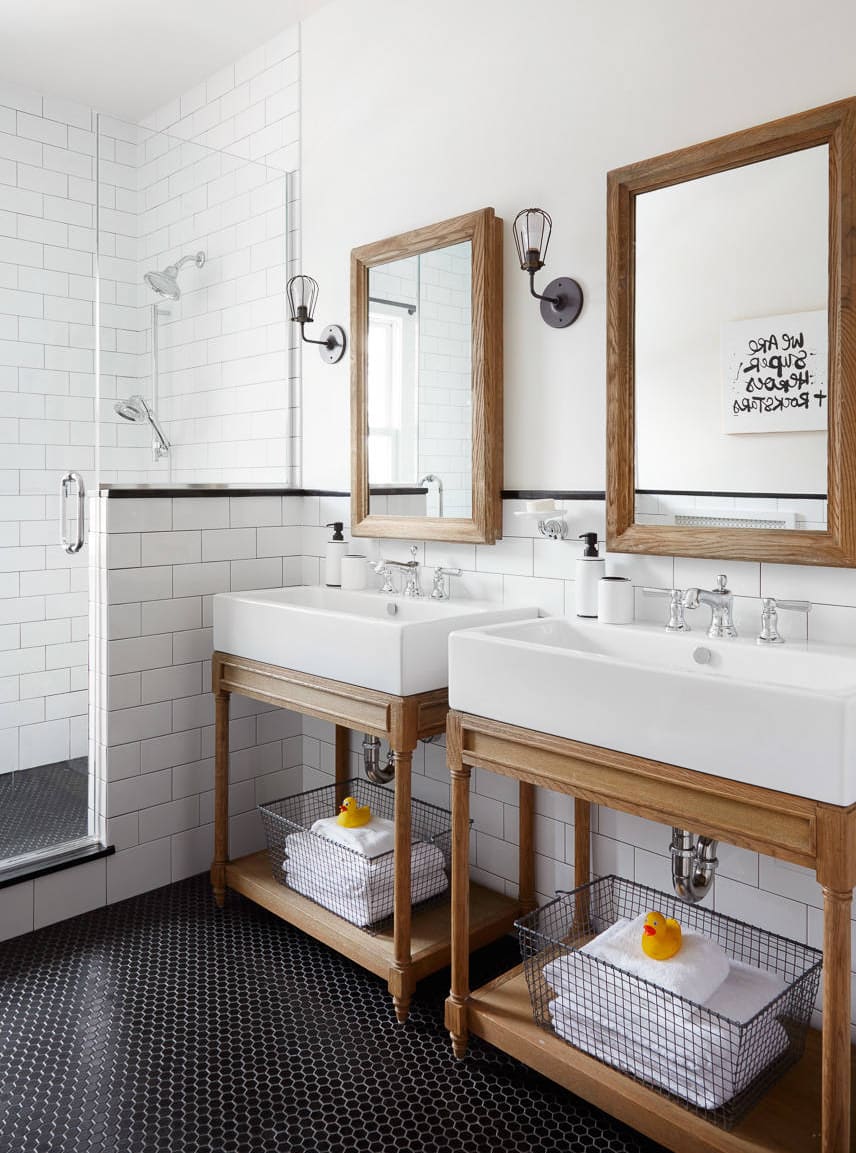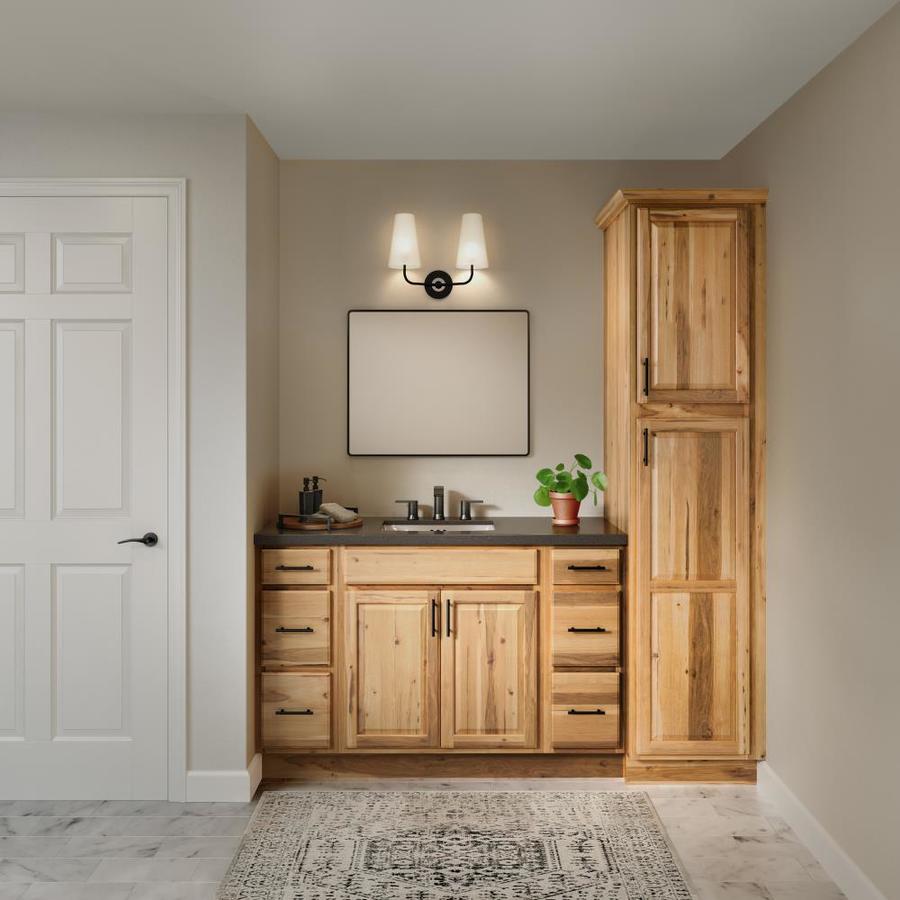What is a Console Bathroom Vanity?
When you’re thinking about remodeling or updating your bathroom, the type of vanity you choose can have a huge impact on the overall aesthetic and functionality of the space. One option that’s been gaining popularity is the console bathroom vanity. But what exactly is it, and how does it differ from other types of bathroom furniture? Let’s break down the basics so you can understand if it’s the right choice for your bathroom.
- A Blend of Sink and Storage: A console bathroom vanity is a blend of sink and storage, mounted on legs instead of being fully enclosed like traditional vanities. This design not only gives it an airy, open feel but also makes it a focal point in the bathroom. The sink typically rests atop a countertop, while the area beneath remains open or features minimal shelving, making it an elegant and minimalist option.
- Exposed Legs for an Open Design: One of the defining features of a console vanity is its exposed legs. These legs can be made from various materials, including metal or wood, giving the vanity a distinct look that complements different design styles. The open area beneath the sink allows for a more spacious feel, perfect for small bathrooms or those aiming for a minimalist, modern aesthetic.
- A Historical Nod to Classic Designs: Believe it or not, console vanities have a historical flair. They take inspiration from the washstands that were common in homes during the 18th and 19th centuries. The modern versions, however, update these classic pieces with sleek lines, more durable materials, and better storage options, making them both a stylish and practical choice.
- Customization Options: One of the great things about console vanities is the ability to customize them. You can choose different countertop materials like marble, quartz, or porcelain, and select various finishes for the legs and fixtures. This customization allows you to create a vanity that perfectly fits your style and bathroom design.
- Space-Saving Design: If you’re working with a small or compact bathroom, a console vanity can be a great space-saving solution. Its open design creates the illusion of more space, as the absence of bulky cabinetry gives the room a lighter feel. You can also add open shelves beneath the sink for towel storage or decorative accents.
- Installation and Plumbing Considerations: While a console vanity looks simple, its installation can be a bit tricky. Because the pipes are exposed, you’ll need to ensure the plumbing is neat and attractive. Many homeowners opt for stylish fixtures or coverings to make the exposed plumbing a feature rather than an eyesore.
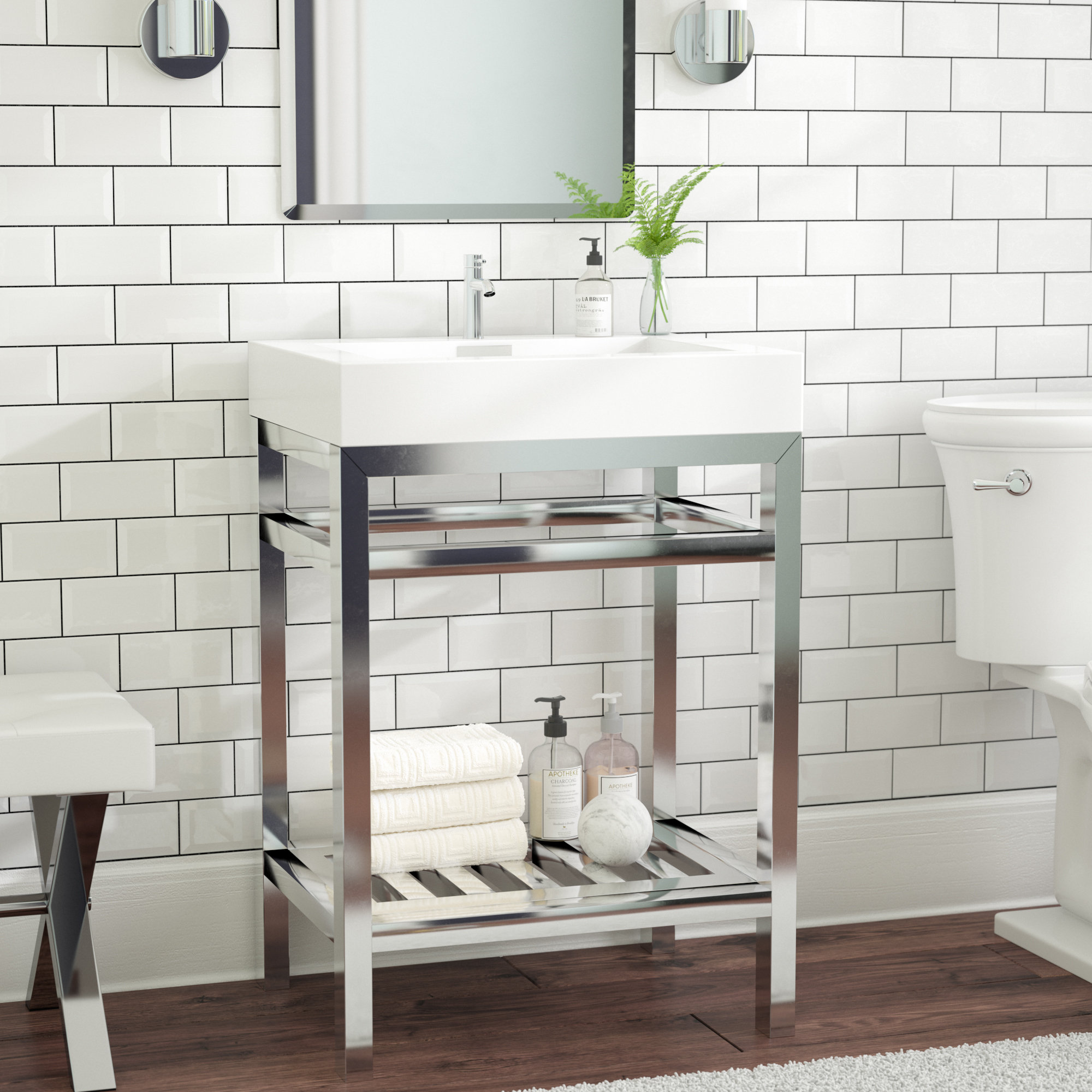
Why Choose a Console Bathroom Vanity
If you’re contemplating a console vanity for your bathroom, you might be wondering what makes it stand out from other types of vanities. Some several key benefits and features make this style of vanity an appealing option for both design and functionality. Let’s see why you might want to consider it for your next bathroom update.
Airy and Open Aesthetic: One of the standout features of a console vanity is its open and airy design. Unlike bulky cabinet-style vanities, a console vanity sits on legs, leaving the area underneath open. This gives your bathroom a spacious feel, even in smaller rooms. It’s perfect if you’re looking to create a clean, minimalist aesthetic.
Versatile Design Options: Console vanities come in a wide range of styles, from traditional to modern. Whether you prefer a sleek metal frame with a marble top or a rustic wood finish with simple lines, there’s a console vanity to suit your taste. The versatility in design means you can easily integrate it into your existing bathroom décor.
Maximizing Floor Space: If you have a smaller bathroom, maximizing floor space is always a priority. The console vanity’s design leaves the floor beneath the sink open, which not only creates the illusion of more space but also makes cleaning much easier. Plus, you can always add baskets or shelving for extra storage if needed.
A Timeless, Elegant Look: Console vanities have a timeless appeal. While their roots are in classic, historical designs, the modern interpretations are sleek and sophisticated. Whether your bathroom is contemporary, vintage, or somewhere in between, a console vanity adds an element of refined elegance.
Customization Potential: One of the most appealing aspects of a console vanity is how customizable it is. You can choose from different countertop materials, finishes for the legs, and types of sinks to create a truly unique vanity. This level of customization allows you to match the vanity to your style and the overall aesthetic of your bathroom.
Increased Flexibility: Because console vanities are available in so many sizes and configurations, they offer greater flexibility in bathroom design. Whether you’re working with a powder room, master bath, or guest bathroom, you can find a console vanity that perfectly fits your space and enhances the overall layout.
Best Materials for Console Bathroom Vanities
When it comes to choosing a console bathroom vanity, one of the most important decisions is selecting the right material. After all, the material you choose will determine both the durability and style of your vanity. With so many options out there, it can be tough to decide. Below, I’ll break down the best materials to consider and why each one might work for your space.
Marble: Luxury and LongevityMarble is one of the most luxurious materials you can choose for a console vanity. It’s durable, naturally beautiful, and adds an air of sophistication to any bathroom. The unique veining patterns ensure that no two marble vanities look exactly alike. However, marble requires regular maintenance to avoid stains and water damage, so it’s ideal if you’re willing to take care of it.
Wood: Warmth and Natural BeautyIf you’re aiming for a more rustic or natural look, wood is a great option for a console vanity. It adds warmth and texture to the space, and you can choose from different types of wood like oak, walnut, or teak. Many wood vanities are treated to withstand moisture, but it’s still essential to ensure proper ventilation in the bathroom to prevent warping over time.
Metal: Sleek and ModernFor a modern or industrial vibe, metal is the way to go. Metal console vanities are sleek, durable, and easy to clean. You can opt for polished chrome, brushed nickel, or even matte black finishes depending on your style. Metal also pairs well with other materials like glass or stone for a striking, contemporary look.
Ceramic or Porcelain: Classic and Easy to MaintainCeramic and porcelain are classic choices for bathroom vanities. They are highly durable, water-resistant, and easy to clean, making them ideal for busy households. These materials also offer a smooth, glossy finish that’s easy to match with different bathroom styles, from traditional to modern.
Quartz: Low Maintenance and High PerformanceQuartz is a fantastic material for a console vanity if you want the look of natural stone without the high maintenance. It’s non-porous, stain-resistant, and available in a variety of colors and patterns. Quartz is also highly durable and easy to clean, making it a practical choice for a bathroom that gets a lot of use.
Glass: Sleek and SophisticatedFor a sleek, modern look, a glass countertop or accents can be an elegant option. Glass vanities can create the illusion of more space and are easy to clean. However, they can show water spots and fingerprints easily, so regular upkeep is required.
Modern vs. Traditional Styles
When it comes to bathroom vanities, the console-style stands out as one of the most versatile options. But with so many design possibilities, how do you decide between modern or traditional styles? Each offers a unique look and feel, and the right one depends on your overall bathroom aesthetic and personal preferences. Below are the differences between these two styles to help you find the perfect fit.
Modern Console Vanities: Sleek and MinimalistIf you love clean lines and a clutter-free look, a modern console vanity is the way to go. These vanities focus on simplicity, with streamlined designs and minimal decorative elements. Think straight edges, smooth surfaces, and neutral color schemes. Materials like glass, metal, and quartz are commonly used in modern designs, often paired with minimalist fixtures in matte black or brushed nickel.
Traditional Console Vanities: Elegant and TimelessOn the other hand, if you prefer a more classic, ornate look, traditional console vanities are the perfect choice. These vanities often feature intricate details such as carved wood, decorative legs, and rich materials like marble or granite. Brass or antique-style faucets are common, adding to the overall sense of elegance and timelessness.
Blending Styles: Transitional Console VanitiesCan’t decide between modern and traditional? Transitional vanities offer a blend of both styles, creating a balanced look that combines the best of both worlds. For example, you might have a sleek, minimalist frame paired with a more ornate marble countertop. This style works well in bathrooms that mix contemporary and vintage elements.
Color Schemes: Bold vs. NeutralWhen it comes to colors, modern vanities tend to stick to neutral palettes—think whites, blacks, grays, and metallic finishes. These colors help maintain the clean and crisp appearance that modern design is known for. Traditional vanities, on the other hand, often incorporate warmer tones such as deep browns, rich woods, or creamy whites. Both styles offer options to suit your bathroom’s color scheme, but modern designs are more likely to experiment with bolder colors like navy or emerald green.
Storage and FunctionalityModern console vanities typically prioritize a sleek, open design, which may limit storage options. You’ll often find them with minimal shelving or even just the countertop and sink. Traditional vanities, however, often incorporate more storage solutions, like small cabinets or drawers built into the vanity. If you need more storage but love the look of a modern console, adding baskets or under-sink shelving can offer a practical solution.
Which Style is Right for You?Choosing between modern and traditional ultimately comes down to your style and the overall look you want to achieve in your bathroom. If you love simplicity and prefer a contemporary, uncluttered space, a modern console vanity is the perfect fit. But if you gravitate toward more classic, detailed designs, a traditional console vanity will add that timeless elegance to your bathroom.
How to Choose the Perfect Console Vanity for Your Bathroom Size
Selecting the right console vanity for your bathroom can be a game-changer, but it’s important to choose one that fits your space. Console vanities come in various sizes and styles, and finding the right balance between aesthetics and functionality is key. Here’s a guide to help you choose the perfect console vanity based on your bathroom’s size.
Small Bathrooms: Prioritize Space and EfficiencyIf you’re working with a small bathroom or powder room, the right vanity can make a world of difference. Look for compact console vanities that offer a minimalist design with a smaller footprint. The open-leg structure of a console vanity can help create the illusion of more space, making the bathroom feel larger and more open. You can also add a floating shelf underneath for additional storage without taking up much room.
Medium-Sized Bathrooms: Balance Style and FunctionalityFor medium-sized bathrooms, you have more flexibility to choose a vanity that balances style with storage. A mid-sized console vanity with a wider countertop allows for more sink and storage space while maintaining the open, airy feel of the design. Consider a double-sink option if your bathroom is shared or if you want to maximize the vanity’s functionality.
Large Bathrooms: Go Big with a Statement VanityIn a large bathroom, you have the luxury of going big with your console vanity. A wide, double-sink console vanity can act as a focal point in the room. You can also experiment with more dramatic designs, like using bold materials (think marble or stone) or adding elegant, ornate legs. With larger vanities, you’ll also have more space for storage, such as open shelving or even integrated towel racks.
Consider the Depth of the VanityWhile width is an important factor, don’t forget about the depth of the vanity. In smaller bathrooms, a shallow console vanity will save space while still offering plenty of surface area for daily use. In larger spaces, you can opt for deeper vanities to add more countertop space, especially if you need room for toiletries or decorative items.
Match the Vanity’s Style to Your Bathroom’s LayoutThe style of your console vanity should complement the overall layout of your bathroom. If you have a narrow bathroom, a console vanity with slender legs and an elongated countertop will create a more open flow. In larger, square-shaped bathrooms, you can opt for a more robust design with wider legs and a thicker countertop for balance.
Take Plumbing Into AccountBefore purchasing a console vanity, consider your bathroom’s plumbing. Console vanities usually expose plumbing beneath the sink, so if your plumbing isn’t aesthetically pleasing, you may need to invest in new fixtures or pipe covers. Alternatively, you could work with a plumber to relocate the pipes for a cleaner look.
Installation Tips: DIY vs. Professional Help
Once you’ve chosen the perfect console bathroom vanity, the next step is installation. While console vanities may seem simpler to install than traditional ones due to their open design, there are still some important considerations to keep in mind. Here’s a guide on how to approach installation and decide whether to tackle it yourself or call in the pros.
Assess Your Skill LevelBefore jumping into a DIY installation, take an honest look at your skill level. Installing a console vanity may seem straightforward, but it can involve several steps, including plumbing work, mounting the vanity, and possibly making adjustments to fit the space. If you have experience with home improvement projects, you may feel confident taking on the job yourself. However, if plumbing and precise measurements aren’t your forte, hiring a professional might be worth the investment.
Gather the Right ToolsIf you decide to go the DIY route, you’ll need the right tools to get the job done. These may include a wrench set for the plumbing, a level to ensure the vanity is properly aligned, mounting brackets or screws, and sealant to secure the sink. Having everything prepared ahead of time will make the process much smoother.
Dealing with PlumbingOne of the most challenging aspects of installing a console vanity is dealing with the plumbing. Since the pipes are usually exposed, you’ll want to make sure they look neat and are properly installed. If your current plumbing setup doesn’t align with the new vanity, you may need to reroute the pipes. This is where professional help comes in handy, especially if you’re not comfortable working with plumbing.
Mounting the VanityConsole vanities often require wall mounting, especially if the legs are more decorative than functional. Ensure that your wall can support the weight of the vanity, particularly if it’s made of heavy materials like stone or marble. You’ll need to locate the wall studs and use proper anchors to securely mount the vanity. If the vanity comes with an installation guide, follow it closely to avoid mistakes.
Adding Finishing TouchesOnce the vanity is installed and the plumbing is connected, don’t forget to add the finishing touches. This includes sealing around the sink to prevent water damage, adjusting the faucet, and ensuring that the vanity is level. A professional installer can also help ensure that all finishing details are perfect, giving your bathroom a polished, cohesive look.
When to Call a ProfessionalIf you’re feeling unsure about any part of the installation process, or if the project becomes more complicated than anticipated, it’s always a good idea to call in a professional. While DIY can save you money, a poorly installed vanity can lead to water damage, misaligned plumbing, or a vanity that isn’t level. Hiring a professional ensures that everything is done correctly the first time, which can save you headaches and repair costs down the line.
Maintenance and Care for Console Bathroom Vanities
Now that you’ve invested in a beautiful console bathroom vanity, you’ll want to keep it looking its best for years to come. Console vanities, like any bathroom fixture, require regular maintenance to ensure they remain in top condition. Here’s how you can care for your console vanity and maintain its beauty over time.
Regular Cleaning is KeyThe easiest way to maintain your console vanity is by cleaning it regularly. Dust can accumulate on the open legs and beneath the vanity, so wipe these areas down frequently. For the countertop, use a gentle, non-abrasive cleaner suited to the material—whether it’s marble, wood, or metal. Avoid harsh chemicals, which can damage surfaces and fixtures.
Prevent Water DamageWater damage is a common concern in bathrooms, especially around vanities. Make sure to wipe down any water that splashes onto the countertop or base after each use. If your vanity is made of wood or has wooden accents, consider applying a protective sealant to prevent moisture from seeping into the material over time.
Address Scratches and StainsDespite your best efforts, scratches and stains may still occur. For stone countertops, such as marble or quartz, use a specialized cleaner to remove surface stains. Wood vanities may need occasional refinishing if scratches appear. For metal legs or frames, a metal polish can help restore their original shine if they become dull or tarnished.
Check for Loose FixturesOver time, the fixtures on your console vanity, such as faucets, handles, or towel racks, may become loose or wobbly. It’s a good idea to periodically check and tighten these fixtures to prevent any long-term damage. If a fixture becomes damaged, replace it promptly to maintain the vanity’s overall aesthetic.
Reseal Stone and Wood SurfacesIf your vanity is made of natural stone or wood, it may need to be resealed periodically to protect it from water and wear. Marble and granite countertops, in particular, benefit from a sealing treatment once a year to prevent staining and etching. Similarly, wood surfaces should be treated with a sealant to keep them looking fresh and protected from moisture.
Polish Metal ElementsConsole vanities often feature metal components, like the legs or fixtures. Over time, these metal parts can become tarnished or dull. To maintain their shine, regularly polish them with a soft cloth and metal cleaner. For chrome or stainless steel fixtures, a mild cleaner and a microfiber cloth will help prevent smudges and fingerprints.
Bathroom Vanities – Empire Industries Metal Collection Vanity
- Gray Bathroom Vanity With Top
- Best Led Light Bulbs For Bathroom Vanity
- Bathroom Vanity Tops With Offset Sink
- Photos Of Bathroom Vanities
- 36 Grey Bathroom Vanity
- Bathroom Vanity With Step Stool
- Bathroom Vanity Cabinets Single Sink
- White Bathroom Vanity Single Sink
- Bathroom Vanity Powder Room
- Unique Bathroom Vanity Lights

